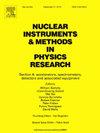The new KM3NeT Detection Units
IF 1.5
3区 物理与天体物理
Q3 INSTRUMENTS & INSTRUMENTATION
Nuclear Instruments & Methods in Physics Research Section A-accelerators Spectrometers Detectors and Associated Equipment
Pub Date : 2024-11-13
DOI:10.1016/j.nima.2024.170066
引用次数: 0
Abstract
KM3NeT is a distributed, deep-sea, Cherenkov neutrino observatory under construction in the Mediterranean Sea with two detectors: ARCA, close to Italy, for neutrino astronomy, and ORCA, close to France, for studying the neutrino oscillations. Each detector is made of a large three-dimensional lattice of optical modules, connected and controlled from a remote shore-station. Each optical module is a submarine node of an extended ethernet network, comprising the onshore computing resources for the online collection and filtering of the acquired data. The data acquisition system follows the trigger-less streaming readout paradigm, with a modular and scalable design which allows the KM3NeT Collaboration to take data since the very first stages of installation. After the first phase of construction, we improved the connectivity of the optical modules, by adding new layers of data aggregation at the detector. This was achieved by means of White Rabbit switches with a readapted form-factor, fitting the KM3NeT underwater vessels. We refer to them as “Wet” White Rabbit switches, in relation to their “Dry” counterparts in the shore-stations. Wet and Dry White Rabbit switch-fabrics allow also the distribution of the timing to the optical modules with the required nanosecond accuracy, according to the standard White Rabbit protocol developed at CERN. In this work we review the evolution of the KM3NeT Detection Units, focusing on the recent changes in the architecture, manufacturing and testing processes.
新型 KM3NeT 检测装置
KM3NeT 是一个分布式深海切伦科夫中微子观测站,正在地中海建造,有两个探测器:ARCA 位于意大利附近,用于中微子天文学;ORCA 位于法国附近,用于研究中微子振荡。每个探测器都由一个由光学模块组成的大型三维晶格构成,通过远程岸站进行连接和控制。每个光学模块都是一个扩展以太网的海底节点,包括用于在线收集和过滤所获数据的岸上计算资源。数据采集系统采用无触发流式读出模式,具有模块化和可扩展的设计,使 KM3NeT 协作项目能够从安装的最初阶段就开始采集数据。在第一阶段的建设之后,我们改进了光学模块的连接,在探测器上增加了新的数据汇聚层。这是通过白兔开关实现的,它的外形经过重新调整,与 KM3NeT 水下容器相匹配。相对于岸上的 "干式 "白兔开关,我们将其称为 "湿式 "白兔开关。根据欧洲核子研究中心(CERN)开发的标准白兔协议,湿式和干式白兔开关织物还能以所需的纳秒级精度将定时分配到光学模块。在这项工作中,我们回顾了 KM3NeT 探测单元的发展历程,重点介绍了最近在结构、制造和测试过程中发生的变化。
本文章由计算机程序翻译,如有差异,请以英文原文为准。
求助全文
约1分钟内获得全文
求助全文
来源期刊
CiteScore
3.20
自引率
21.40%
发文量
787
审稿时长
1 months
期刊介绍:
Section A of Nuclear Instruments and Methods in Physics Research publishes papers on design, manufacturing and performance of scientific instruments with an emphasis on large scale facilities. This includes the development of particle accelerators, ion sources, beam transport systems and target arrangements as well as the use of secondary phenomena such as synchrotron radiation and free electron lasers. It also includes all types of instrumentation for the detection and spectrometry of radiations from high energy processes and nuclear decays, as well as instrumentation for experiments at nuclear reactors. Specialized electronics for nuclear and other types of spectrometry as well as computerization of measurements and control systems in this area also find their place in the A section.
Theoretical as well as experimental papers are accepted.

 求助内容:
求助内容: 应助结果提醒方式:
应助结果提醒方式:


